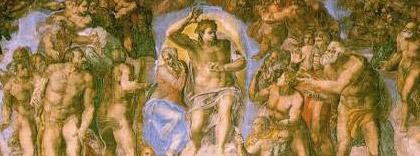Michelangelo returned to the Sistine Chapel as a sixty-year-old man in 1535 when he was commissioned by Pope Paul III (pontificate 1534 – 1549) to paint the Altar Wall.
A Vivid Contrast
If his ceiling celebrates the creation of man, his Last Judgement, painted eight years after the Sack of Rome (1527), which Michelangelo bore witness to, is a powerful, even frightening image of the condemnation of man.
Michelangelo placed the dark entrance to Hades exactly where the gaze of the priest reading mass would fall. A radiating spiral from the central figure of Christ is the dominating compositional device and one that the artist might have borrowed from the theories of Copernicus (1473 – 1543), whom Michelangelo admired.
Christ and his mother, Mary, are the central figures and the only ones that were clothed in the original finished fresco. Mary is turning away from her son. So terrible does she see his judgment. If there is any hesitation in calling his Last Judgement on the man whom he loves, he is reminded of the brutality of man by the saints that surround him bearing the symbols of their own martyrdom.
On the left side, the blessed are raised to heaven, while on the right, the damned are flung down into purgatory. Angels carry the cross and the crown of thorns on the top left, while other angels struggle with a column from the villa of Pontus Pilate, top right.
A Testament to Justice
Michelangelo’s Last Judgement is a testimony to the artists’ sense of religious and social justice. It may also be seen as his own bitter judgment in the Sistine Chapel against all those critics that sort to discredit his work.
Ironically what remains today is the rapture of critics, as they are overwhelmed by the towering artistic genius of vision and skill that we enjoy in Michelangelo’s Last Judgement.

‘The Last Judgement’ by Michelangelo, Sistine Chapel in the Vatican, Rome.